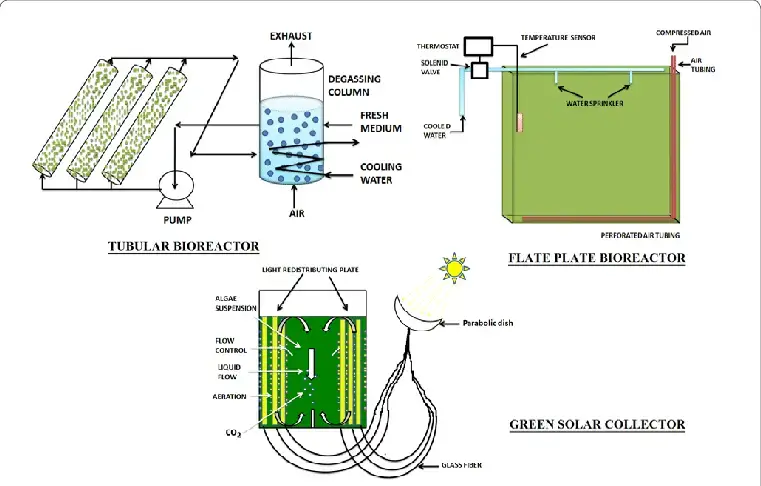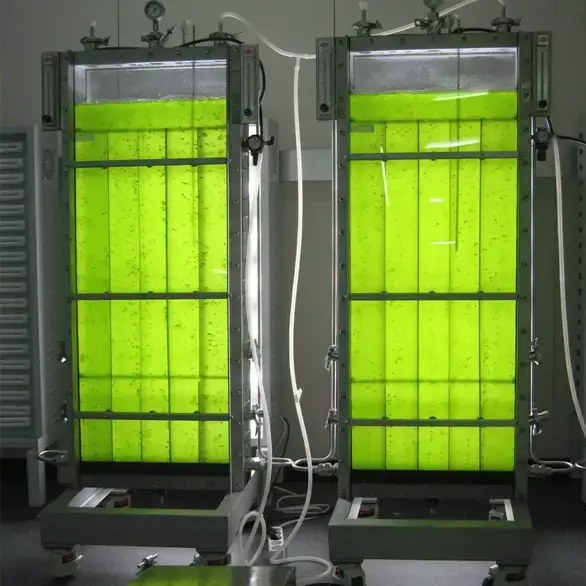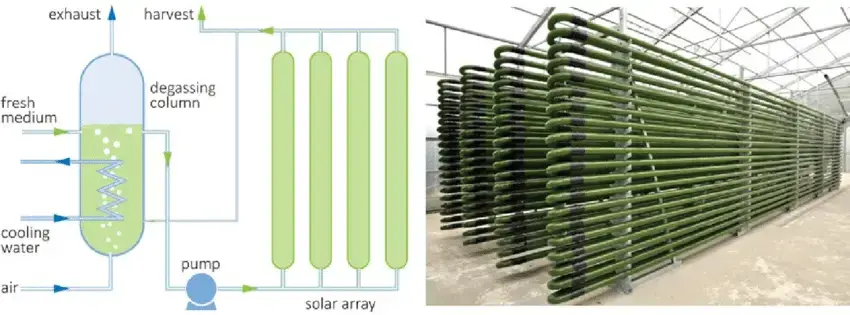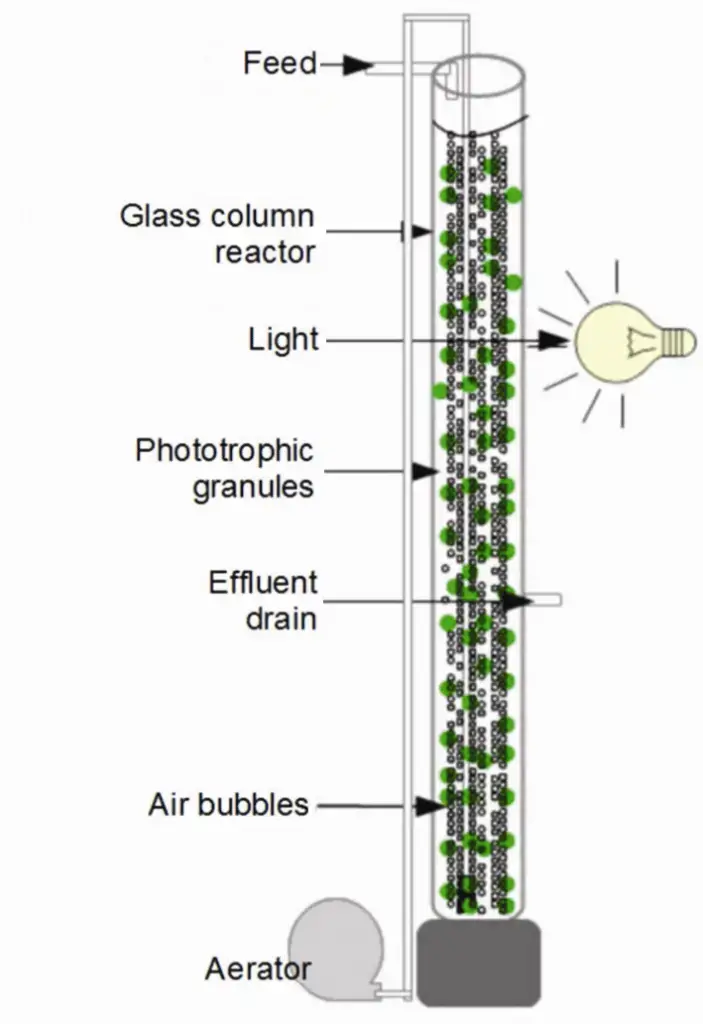The Algae Bioreactor is a closed system that treats wastewater and produces biofuels using algae. The earliest commercial applications of algae bioreactors occurred in the 1960s for wastewater treatment. With the increasing global demand for alternative energy sources, the usage of algae bioreactors for biofuel production has risen to prominence in the 21st century.
The advantages of algae bioreactors over conventional wastewater treatment technologies are numerous. Algae devour organic contaminants and nutrients in wastewater, lowering waste volume and offering a natural treatment option. Algae can also be utilised to make biofuels such as biodiesel and biogas, which helps reduce reliance on fossil fuels and greenhouse gas emissions.
Algae bioreactors have the potential to transform wastewater treatment and contribute to a more sustainable energy future.
Contents
What is Algae Bioreactor?
- A bioreactor is utilised to cultivate micro and macro algae. In the form of an algae scrubber, algae can be cultivated for biomass production (as in a seaweed cultivator), wastewater treatment, CO2 fixation, and aquarium/pond filtration.
- In terms of construction, algae bioreactors fall into two basic categories: open reactors and enclosed reactors. Open reactors are exposed to the atmosphere, whereas enclosed reactors, also known as photobioreactors, are isolated from the atmosphere to variable degrees.
- Algae bioreactors can be used to manufacture biodiesel and bioethanol, provide animal feed, and reduce pollutants such as NOx and CO2 in power plant flue gases.
- This type of bioreactor is fundamentally based on the photosynthetic process performed by chlorophyll-containing algae using dissolved carbon dioxide and solar energy.
- Carbon dioxide is disseminated in the reactor fluid to make it available to algae. The bioreactor must be constructed from a transparent substance.
- It has been shown that the initial culture of microalgae was unicellular. In 1890, the Dutch microbiologist Martin Beijerinck discovered Chlorella vulgaris. During World War II, Germany utilised open ponds to expand algal culture for protein supplementation.
- Washington’s Carnegie Institution for Science undertook some of the earliest research aimed at producing algae in 1957. In these trials, monocellular Chlorella was grown with the addition of CO2 and minerals. The objective of this study was to cultivate algae to generate inexpensive animal feed.

Microalgae Metabolism
- Algae are predominantly photoautotrophic eukaryotic organisms that produce oxygenic photosynthesis. These species of algae are categorised by the pigments responsible for their colour, which absorb light.
- The green algae species, also known as Chlorophyta, are frequently utilised in bioreactors due to their rapid development and resistance to a variety of conditions. Due to the absence of a nucleus, blue-green algae, commonly known as cyanobacteria, are categorised as prokaryotic photoautotrophs.
- Light provides the cell with the necessary energy to digest carbon dioxide, nitrogen, phosphorus, and other vital elements. Light’s wavelengths and intensities are crucial components of a successful.
- Due to the lower concentration of CO2 in our atmosphere, additional CO2 can be added to the atmosphere, as demonstrated by the bubble column PBR below.
- Microalgae may also absorb extra nitrogen and phosphorus under starving conditions, which are needed for lipid and amino acid synthesis. In addition, higher temperatures and pH levels between 7 and 9 are also common contributors.
- Each of these parameters might vary from species to species, thus it’s crucial to construct bioreactors with the appropriate environmental conditions.
Characteristics/Features of Algae Bioreactor
Algae bioreactors are meant to develop algae for a range of applications, including biofuel generation, wastewater treatment, and air cleaning. Important features of algal bioreactors include:
- Controlled environment: Algae bioreactors are meant to provide a regulated environment, including temperature, light, and fertiliser levels, for algae development.
- Photobioreactor design: Photobioreactors are a prevalent form of algae bioreactor that are intended to enhance light exposure for algae growth. They are frequently packaged in clear tubes, tanks, or sacks.
- Aeration: Algae bioreactors frequently require aeration to supply sufficient oxygen for algae development and prevent anaerobic situations.
- Harvesting: Algae bioreactors must have a harvesting method, such as a centrifuge or filtration system, for the algae.
- Monitoring and control: Algae bioreactors typically feature monitoring and control systems to regulate the environment and optimise algae development.
Algae bioreactors are, in general, complicated systems that necessitate careful design and maintenance for best performance.
Components of Algae Bioreactor
The components of an algae bioreactor can vary depending on the specific design and purpose of the bioreactor. However, common components include:
- Light source: Algae bioreactors require a light source to provide energy for photosynthesis and algae growth. This can be natural light or artificial light, such as LED lights.
- Culture vessel: This is the container that holds the algae culture. It can be made of materials such as glass, plastic, or metal and can take the form of tubes, tanks, or bags.
- Mixing and aeration system: Algae bioreactors require a method of mixing and aerating the culture to prevent stratification and to provide oxygen for algae growth.
- Nutrient delivery system: Algae bioreactors require a system for delivering nutrients to the algae culture, such as fertilizer or wastewater.
- Harvesting system: A mechanism for harvesting the algae from the culture is necessary, such as a centrifuge or filtration system.
- Monitoring and control system: This includes sensors and controllers to monitor and regulate temperature, light, pH, and other parameters important for algae growth.
- Power and control systems: These include electrical and electronic components to power the bioreactor and control systems.
These are the basic components of an algae bioreactor, and additional components may be added depending on the specific design and purpose of the bioreactor.
How does Algae Bioreactor works?
An algae bioreactor works by creating an optimized environment for algae growth, providing the necessary light, nutrients, and other conditions for photosynthesis and algae reproduction. The general process can be described as follows:
- Culture preparation: The algae culture is prepared by mixing algae cells with water and nutrients in the culture vessel.
- Light exposure: The algae bioreactor provides a light source for photosynthesis and algae growth. This can be natural light or artificial light, such as LED lights.
- Aeration: The culture is mixed and aerated to provide oxygen for algae growth and to prevent stratification.
- Nutrient delivery: The bioreactor delivers nutrients to the algae culture, such as fertilizer or wastewater.
- Monitoring and control: Sensors and controllers monitor and regulate the environment, including temperature, light, pH, and other parameters important for algae growth.
- Algae growth: The algae cells reproduce and grow in the optimized environment provided by the bioreactor.
- Harvesting: The algae are harvested from the culture, usually by centrifugation or filtration.
This process can be repeated to produce a continuous supply of algae for various applications, such as biofuel production, wastewater treatment, and air purification.
Types of Algae Photobioreactors
Three fundamental algae photobioreactor types include:
- Plate Photobioreactor
- Tubular Photobioreactor
- Bubble Column Photobioreactor
1. Plate Photobioreactor

- A plate reactor comprises merely of vertically stacked or inclined rectangular boxes that are sometimes separated into two portions to achieve fluid agitation. In most cases, these boxes are organised into a system by tying them together.
- These connections also facilitate the filling/emptying process, the introduction of gas, and the delivery of nutritional chemicals. Flue gas is mostly introduced towards the bottom of the box so that carbon dioxide has sufficient time to interact with algae in the reactor fluid.
2. Tubular Photobioreactor

- A tubular reactor is comprised of vertically or horizontally stacked tubes that are connected by a pipe network. The fluid containing suspended algae can circulate in this tubing. The tubes are often composed of transparent polymers or borosilicate glass, and a pump at the end of the system maintains steady circulation.
- The gas is introduced at the beginning/terminus of the tube system. This method of gas introduction results in a lack of carbon dioxide, a high concentration of oxygen at the end of the unit during circulation, and poor performance.
3. Bubble Column Photobioreactor

- A bubble column photo reactor consists of a transparent, cylinder-shaped column placed vertically. The introduction of gas occurs at the base of the column and creates a turbulent flow for optimal gas exchange. Currently, these sorts of reactors are constructed with a maximum diameter of 20 cm to 30 cm to ensure sufficient solar energy supply.
- The limited diameter of the sunlight-determined structure poses the greatest challenge. Feuermann et al. developed a method to collect sunlight with a cone-shaped collector and transfer it with some fibreglass cables that are adapted to the reactor to enable constructions of a column reactor with larger diameters. – on this scale, the energy consumption due to pumps, etc., and the CO2 cost of manufacture may outweigh the CO2 captured by the reactor.
Why Use an Algae Bioreactor?
Algae bioreactors are utilised for numerous reasons, including:
- Biofuel production: Algae can be utilised in the manufacture of biofuels such as biodiesel, ethanol, and hydrogen.
- Wastewater treatment: Algae are capable of removing contaminants from wastewater, including nitrogen and phosphorus.
- Air purification: Carbon dioxide and other air pollutants can be absorbed by algae, which makes them ideal for air cleansing.
- Food and animal feed: Some types of algae are edible and can be utilised for human and animal nutrition.
- Pharmaceuticals: Algae are capable of producing numerous substances with potential medical applications, including anti-inflammatory drugs, anti-tumor agents, and anti-viral agents.
Algae bioreactors offer a variety of possible advantages and applications, making them a valuable tool for a vast array of industries and purposes.
Uses of Algae Bioreactor
- The cultivation of algae in a photobioreactor generates a limited number of industrial applications.
- Some power firms have already set up research facilities with algal photobioreactors to determine how effective they could be at lowering flue gas CO2 emissions and how much biomass will be produced.
- Algae biomass has numerous applications and can be sold to produce extra revenue. By selling emission credits to other power providers, the emission volume saved can also generate cash.
- In East Asian regions, the consumption of algae as food is widespread. The majority of species have only a little amount of useable proteins and carbs, in addition to an abundance of minerals and trace elements.
- Algae should be used sparingly due to their high iodine concentration, which is particularly hazardous for persons with hyperthyroidism.
- Similarly, numerous species of diatomaceous algae create chemicals that are harmful to humans. By separating and purifying the algae’s fractions, biodiesel and bioethanol can be produced, especially from those species that contain more than 50 percent oil and a large amount of carbohydrates.
- This is a really intriguing point because the biomass of algae is produced 30 times faster than agricultural biomass, which is frequently utilised to produce biodiesel.
Advantages of Algae Bioreactor
- Prevent contamination: Invading and/or native species have the potential to contaminate open ponds, which is, in my opinion, one of the greatest issues with open ponds. In a PBR, you have perfect control over all inputs, rather than chance or nature. This is a MASSIVE benefit.
- Allow you to grow algae in any climate: Being able to cultivate algae in any climate is one of the primary functions of a PBR. It enables for the simple and inexpensive cultivation of algae in practically any climate. In many colder climates, open ponds are an unsuitable option.
- Bioreactors provide enhanced management of existing conditions: Since you are in charge of all inputs, you can also (better) regulate the conditions of your algae studies. Climate, light, temperature, pH, nutrients, etc. Frequently, this is not practicable on an open pond. For instance, it is difficult to regulate the amount of sunshine in a certain area. However, resetting a PBR is as easy as resetting a timer.
- Prevent water evaporation: It can be difficult to prevent water evaporation in an open pond. When water is scarce, open ponds are an unacceptable option.
- Lower carbon dioxide losses: If you have an unlimited source of waste carbon dioxide, this is not a problem; however, most residential users do not live adjacent to a power plant, therefore they must purchase carbon dioxide in canisters. In order to reduce expenses, this becomes a factor to consider.
- Permit higher cell concentrations: Since you’re in control of the PBR’s parameters, you can also regulate the density of your cell colonies. Although achievable in an open pond, it is significantly simpler in a PBR.
Disadvantages of Algae Bioreactor
- Cost: Algae bioreactors were previously considered the domain of corporations due to their expensive manufacture. In fact, the high price of acrylic tubes, especially as the price of oil rises, is sufficient to cause pause. “Yankee ingenuity” is the key to managing the price of PBRs.
- Certainly, it is always feasible to complicate matters and add fees. There is no problem there. To use current, inexpensive, local resources to develop a PBR, however, no expertise existed. Before now. This is one of the primary motivations for writing this book.
- Size and scope: Algae bioreactors have been confined to laboratories for the most part, and comparatively few have been constructed for large-scale production. This is now evolving. The size and scope of your algae bioreactor will also rely on the intended use. Many (most) applications do not require a significant PBR, such as dietary supplements. With a tiny PBR, you can easily produce all the Spirulina and/or chlorella your household requires. For example, algae biofuels are at the opposite end of the range. To be effective in this situation, you must cultivate a significant quantity of algae.
FAQ
What is an Algae Bioreactor?
An Algae Bioreactor is a system designed to grow algae in controlled conditions to produce a variety of products such as biofuels, food and feed, pharmaceuticals, and chemicals. These systems typically consist of a container or vessel that provides a suitable environment for algae growth, along with various components such as lighting, nutrient delivery, and gas exchange.
How does an Algae Bioreactor work?
An Algae Bioreactor works by providing the ideal conditions for algae growth such as temperature, pH, light, and nutrients. The algae grow in a closed system that allows for precise control of the environment, which can result in high levels of productivity and quality. Waste products produced by the algae are removed and replaced with fresh nutrients, which allows the algae to continue growing and producing.
What are the benefits of using an Algae Bioreactor?
The benefits of using an Algae Bioreactor include increased productivity, reduced costs, and improved quality of the final product. Algae grown in bioreactors are also free from contaminants and other impurities that can be found in wild-grown algae, which makes the product suitable for a variety of applications. Additionally, algae bioreactors are considered a sustainable solution, as they use less water and energy than other forms of agriculture and do not require large amounts of land.
What are the different types of Algae Bioreactors?
There are several different types of Algae Bioreactors including photobioreactors, raceway ponds, and airlift bioreactors. Each type of bioreactor has its own unique set of advantages and disadvantages, and the choice of which type to use depends on the specific requirements of the project. For example, photobioreactors are well suited for high-density growth and are ideal for applications that require high-quality, pure algae, while raceway ponds are well suited for large-scale production and are often used for biofuels.
How is Algae Bioreactor technology evolving?
Algae Bioreactor technology is constantly evolving, with new and improved systems being developed all the time. Some of the key areas of development include increasing productivity and efficiency, reducing costs, improving the quality of the final product, and developing new applications for algae. In addition, there is also a growing interest in using algae bioreactors to address environmental issues such as carbon capture, water treatment, and waste management. As the technology continues to advance, it is likely that algae bioreactors will play an increasingly important role in addressing some of the world’s most pressing challenges.
How is Algae Cultivated in a Bioreactor?
The cultivation of algae in a bioreactor involves several steps, including selecting the appropriate algae species, providing the right environment and nutrients for growth, and controlling factors such as temperature, light, and pH. The algae can be grown in liquid media or on a solid support material, and the system must be designed to maintain the optimal conditions for growth, while also removing waste products. Once the algae have reached a sufficient density, they can be harvested and processed to produce a wide range of products.
What are the Applications of Algae Bioreactor Technology?
Algae bioreactor technology has a wide range of applications, including the production of biofuels, food and feed, pharmaceuticals, chemicals, and cosmetics. For example, algae can be processed to produce high-value products such as omega-3 fatty acids, which are used in dietary supplements and functional foods, or carotenoids, which are used as food colorants and in animal feed. Algae bioreactors are also being explored as a solution for capturing and reducing greenhouse gases, as well as for water treatment and waste management.
What are the Challenges in Algae Bioreactor Technology?
Despite its potential, algae bioreactor technology faces several challenges, including the high cost of production, the need for efficient harvesting and processing techniques, and the lack of widespread commercialization. In addition, there is also the challenge of scaling up the technology to meet the demands of large-scale production, while maintaining the quality of the final product. Finally, there is also a need for ongoing research and development to improve the efficiency and sustainability of algae bioreactor systems.
What are the Future Trends in Algae Bioreactor Technology?
In the future, algae bioreactor technology is expected to continue evolving and expanding, with a focus on increasing efficiency and reducing costs. There is also a growing interest in developing new applications for algae bioreactors, such as using them for carbon capture and storage, water treatment, and waste management. Additionally, advances in biotechnology are expected to lead to the development of new algae strains with improved properties, and the integration of bioreactors with other technologies such as photovoltaics and aquaponics is also expected to become more widespread.
Related Posts
- Basidiomycetes – Life cycle, Characteristics, Significance, Mycelium and Examples
- Deuteromycetes – Reproduction, Characteristics, Classification and Examples
- Yeast – Structure, Reproduction, Life Cycle and Uses
- Candida albicans – Morphology, Life Cycle, Pathogenesis, Treatment
- Hyphae – Definition, Types, Structure, Production, Functions, Examples











